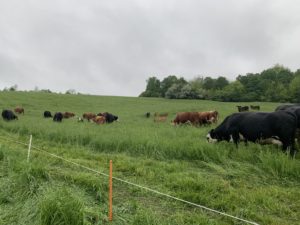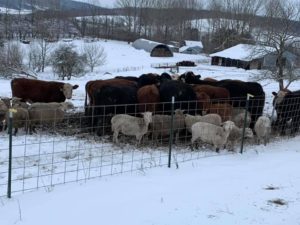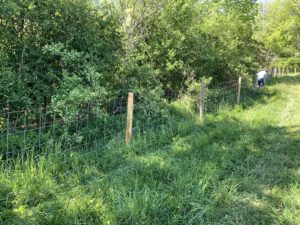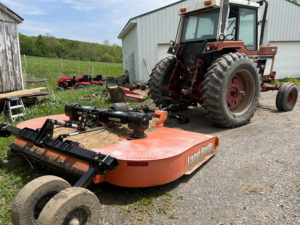Some Fencing and Grazing Considerations for Beef Cattle
In part nine of our “What’s Your Beef?” series on raising cattle on small farms, we share grazing experiences that has been learned about and adapted over the years.

Here is a paddock subdivision made with step in posts and electrified rope.
Rich Taber / CCE Chenango
In this installment I am going to highlight some of the grazing experiences that I have learned about and adapted over the years. In the grazing world, there are hundreds of articles, PowerPoints, books, zooms and people that will show you how to plan for and execute a good grazing management plan for your property; most of them excellent and well worth you availing yourselves of. Rather than simply rehash some of the volumes of information that is out there, I thought that I would write about some specific things that I have learned and adapted for use over the years. In other words, theories embellished with lots of experience.
The experiences that I have garnered over the years may be applied to any class of livestock; beef, sheep, horses, and dairy animals. I learned many years ago about the viability of grasses and grazing for livestock. In the late 1960’s I was a 4-Her living on a small farm in Eastern Connecticut. That was the era of cheap energy and feed grains. We glutted our show animals on inexpensive grain and a little hay; how we did not have more digestive issues than we did amazes me. I had a small group of market lambs that I was feeding for show and meat animal sales at the University of Connecticut. As mentioned, we fed huge quantities of grain to these animals, with no grazing, and a little hay. One day a neighbor came along and wanted to buy a ewe and a couple lambs from me. Away from my barn kept, pampered show lambs and out on pasture I had an old, raggedy Horned Dorset ewe who had two lambs, almost as an afterthought, and just subsisting on a little grass and no grain. When I brought this ewe and her lambs in to sell, I was absolutely stunned to find that the lambs were fat, well-muscled, and as heavy as my market lambs receiving their high-octane grain diets. It was sort of an epiphany for me, learning firsthand that livestock could perform so well on grass. By no stretch was the field these sheep living in a stellar example of grazing management, it was just an old, unimproved pasture/hayfield. Then it dawned on me that much of American beef herds and sheep flocks are raised on rough, unimproved lands in the western part of the country before being sent to midwestern feedlots to be finished, and they subsisted on marginal lands. A seed for grazing (metaphorically speaking) was planted in my mind. Grasses and grazing provide the most nutritious and inexpensive source of feed for ruminant livestock. The concepts of grazing fit in well with my slowly forming ecological and environmental inclinations; we could depend less on fossil fuels and high inputs and let nature do most of the work with green grass!

Fence panels work well for different classes of livestock.
Rich Taber / CCE Chenango
Fast forward to the late 20th and early 21st centuries. I live on a rough, former dairy farm high in the hills of southern Madison County NY. We have long, cold, snowy winters, not the greatest soils, which are acid prone and somewhat poorly drained, but with good amounts of rain most years. We can graze from mid-May till about the end of October, early November. The steep, wet, highly erodible land is not so good for row crops and conventional agriculture but does just fine for grazing.
Another thought that seeped its way into my mind was that whatever I do agronomically with my grazing fields, that I keep economics in mind. If you do everything that all of the many sources of information tell you to do, you can end up spending huge amounts of money. This is ok if you have it, but many times we don’t like to admit it, but we end up spending fair amounts of money from our off-farm jobs to finance our grazing operations. I salivate as much as anyone thumbing through those beautiful seed catalogs replete with many different seed mixes that I might plant. With that being said, I try to keep in mind that what I will be selling on the other end of the grazing cycle as income will repay farm expenses, whether it be a cow/calf beef operation, finishing beef animals, feeder beef cattle, lambs, or dairy heifers. In other words, let’s try to get the animals to pay for themselves.
With these musings in mind, I will now share some of the adaptations that I have found have worked for me over the years as far as grazing goes.
Let’s talk about fencing first. Many people use high tensile electric fencing for their perimeter fences and powered by high energy chargers. This works well for many people and situations, but I have shied away from this practice in recent years, for me, here, on this farm. I dislike depending on anything electric for a perimeter fence for a couple reasons. First, almost all our fence lines are up against woodland edges. Winds, heavy thunderstorms, and snowstorms blow down trees, shorting out fences. This year we had a notable snowstorm dropping 16 inches of heavy, wet snow on much of Upstate New York, shorting out fences all over, and resulting in havoc being wrought by fallen tree limbs. We also had a complete loss of power for 4 days. Yes, we have a PTO driven tractor generator, but we don’t run it 24/7 due to the cost of diesel fuel and the wear and tear on the tractor engine. A couple years ago I have a neighbor who had several beef cows escape when a tree limb shorted out their fence. It took almost 2 months to get these near feral animals caught up again. Loose animals can lead to all sorts of legal ramifications! Think of cow/car collisions, and ruined crops and seedings from unwanted animals!

This shows high tensile woven wire fencing under construction and being attached to cedar posts.
Rich Taber / CCE Chenango
We do use electric fences for all our interior paddock subdivisions, and it works quite well for that purpose. If an animal breeches a paddock, it’s no big deal, at least the animal does not escape the property. What we do fence our perimeters with is either high tensile stretched woven wire, or 16-foot panels purchased from the local big box farm store. Both types work fine for us. It’s expensive, but once up requires little maintenance. If a tree falls on the fence, most times it’s not crushed enough to allow the animals to escape. We use wooden cedar fence posts to attach the woven wire or wire panels to. If you want to use the woven wire, you will need to acquire a jenny that holds the wire in a roll form on your tractors’ three-point hitch which allows you to pay it out before attaching it to the fence posts.
I have also adapted the use of high tensile electrified rope for my interior subdivisions. For the number of cows that we have, I lay out about 4-acre subdivisions with the ropes, using step in plastic posts. The cows remain in each paddock for about 4 days, and then are moved into the next paddock. I have no desire to move animals on a daily basis; you need to do this if you’re milking dairy cows. Many of us with livestock however, work off the farm and it does take a fair amount of time to lay out paddocks and move animals. In that vein, we don’t want to leave animals in a paddock for too long either, such as is seen in continuous grazing. Paddocks do need a given amount of time to recover, and that depends on a myriad of factors such as the time of the season, the condition of the soil, the amount of regrowth that you can expect, and the amount of rain received.
Another area that I have developed some skills in is in bringing back worn-out hay fields and pastures to a good state of production, and without the use of too much tillage. Again, if I were milking dairy cows, I would have to be much more meticulous about this and occasionally replant some good producing varieties of forage. The gross income from beef cattle and sheep does not generate a huge cash flow leaving a lot of unused disposable income to spend.

The author’s two brush hogs used to maintain and reclaim pastures and hayfields, the ten-footer in foreground and the seven-footer in back.
Rich Taber / CCE Chenango
People oftentimes ask me: “How often to you reseed your pastures,” and I reply: “As seldom as possible.” A full tillage reseeding takes huge quantities of machinery, time, fuel, seed, lime, and fertilizer. Plowing, disking, dragging, packing, seeding, and packing again is required. I have no objections if it is required, such as when a field is all rutted or was poorly plowed in the past, and your fillings seem to be jarred loose when driving over it. One of the beauties of grazing however, is that you can maintain your hayfields and pastures with the occasional maintenance applications of fertilizer, manure, compost, or lime done according to soil tests. The use of no till seeders offers possibilities too.
One of the most important tools in my arsenal is the use of brush hogs. I have two on my farm; a 7-footer and a 10-footer. When I get my hands on a new pasture or hayfield that is in poor shape species wise, I have found that brush hogging can work wonders. I have brush hogged some fields infested with horrible concoctions of weeds and thistles that have returned with some beautiful swards of grasses once the weeds are removed. Where to these grasses come from? In a nutshell, from the native seedbank which lies dormant waiting for the right conditions to flourish. I do not use any kind of herbicides on my pastures, being somewhat organic in my leanings.
Soil testing is a must! You cannot continuously graze or remove hay without having to return some nutrients to the soil, whether it be fertilizer, compost, manure, or cover crops!
I also use the brush hogs to clip the pastures; I try to hit every paddock at least once a year but don’t always succeed in doing so. If you don’t, you will see noxious species starting to show up, such as thornapples and briars which if left too long become very difficult to mow.
This is not an end all, exhaustive compendium on grazing theory, just some of the experiences that I have developed over time and that work for me, high in the hills of Madison County! I love grasses and grazing, because it provides for excellent animal products and is ecologically and economically feasible. Good grazing to you all this year!

